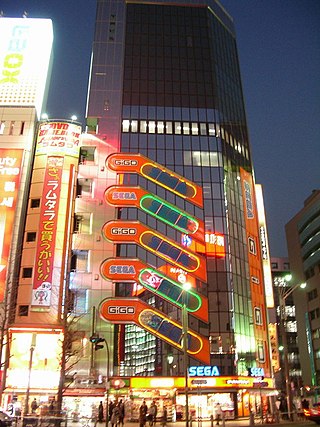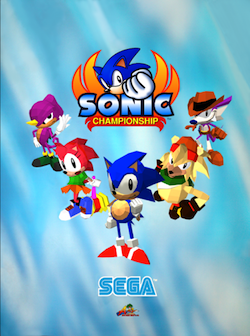
The Sega VR is an unreleased virtual reality headset developed by Sega in the early 1990s. Planned as an add-on peripheral for the Sega Genesis and only publicly showcased at a number of trade shows and expositions, its release was postponed and later cancelled outright after Sega ran into development issues. At least four in-progress games for the hardware were in development before its cancellation.

An amusement arcade, also known as a video arcade, amusements, arcade, or penny arcade, is a venue where people play arcade games, including arcade video games, pinball machines, electro-mechanical games, redemption games, merchandisers, or coin-operated billiards or air hockey tables. In some countries, some types of arcades are also legally permitted to provide gambling machines such as slot machines or pachinko machines. Games are usually housed in cabinets.

Genting Highlands is a hill station located on the peak of Mount Ulu Kali in the Titiwangsa Mountains, central Peninsular Malaysia, at 1800 metres elevation. Located in the state of Pahang, it was established in 1965 by the late Malaysian businessman Lim Goh Tong. The primary tourist attraction is Resorts World Genting, a hill resort where casinos and theme parks are situated and where gambling is permitted. Many of Pahang's skyscrapers can be found here.

Sonic the Fighters, also known as Sonic Championship on arcade versions outside Japan, is a fighting game developed by Sega AM2. First released in 1996 in arcades on Sega's Model 2 arcade system, Sonic the Fighters pits players in one-on-one battles with a roster of characters from the Sonic the Hedgehog series.

Sega AM Research & Development No. 3, known as Hitmaker Co., Ltd. from 2000 to 2004, is a defunct division of Sega, a Japanese video game company. Established by 1993, AM3 was managed by Hisao Oguchi and developed a number of arcade games for Sega. Series introduced by AM3 include Virtual On, Sega Rally, Crazy Taxi, and Virtua Tennis. AM3's main focus was on arcade games until the release of the Dreamcast. Additionally, developers Tetsuya Mizuguchi and Kenji Sasaki developed Sega Rally Championship with AM3 before departing to form AM Annex, which later split into Sega AM9 and Sega AM5.
1997 saw many sequels and prequels in video games, such as Final Fantasy VII, Castlevania: Symphony of the Night, GoldenEye 007, Star Fox 64, Crash Bandicoot 2: Cortex Strikes Back, Quake II, Mega Man Legends, Riven, Tomb Raider II, Dark Rift, Tekken 3 and Virtua Striker 2, along with new titles such as Oddworld: Abe's Oddysee, Gran Turismo, Diablo, Grand Theft Auto and Fallout.
1996 saw many sequels and prequels in video games, such as Super Mario 64, Duke Nukem 3D, Street Fighter Alpha 2, Super Mario RPG, King's Field III, Virtua Fighter 3, along with new titles such as Blazing Heroes, NiGHTS into Dreams..., Crash Bandicoot, Pokémon Red/Green/Blue, Resident Evil, Dead or Alive, Quake and Tomb Raider.

The London Trocadero was an entertainment complex on Coventry Street, with a rear entrance in Shaftesbury Avenue, London. It was originally built in 1896 as a restaurant, which closed in 1965. In 1984, the complex reopened as an exhibition and entertainment space. It became known for the video-game oriented SegaWorld attractions which were added in 1996, and later downscaled and renamed to "Funland" before its closure in 2011. Part of the building was opened as a hotel in 2020.
A family entertainment center (FEC) in the entertainment industry, also known as an indoor amusement park, family amusement center, family fun center, soft play, or simply fun center, is a small amusement park marketed towards families with small children to teenagers, often entirely indoors. They usually cater to "sub-regional markets of larger metropolitan areas." FECs are generally small compared to full-scale amusement parks, with fewer attractions, a lower per-person per-hour cost to consumers than a traditional amusement park, and not usually major tourist attractions, but sustained by an area customer base. Many are locally owned and operated, although there are a number of chains and franchises in the field. Some, operated by non-profit organizations as children's museums or science museums, tend to be geared toward edutainment experiences rather than simply amusement.

SegaSonic the Hedgehog is a 1993 arcade game in the Sonic the Hedgehog series by Sega. Controlling Sonic the Hedgehog and his friends Mighty the Armadillo and Ray the Flying Squirrel, the player must escape an island after they are kidnapped by the villain, Doctor Eggman. The game uses an isometric perspective. Players use a trackball to move the characters while dodging obstacles and collecting rings. The game was developed by Sega's arcade division, Sega AM3. It is one of four Sonic games with the SegaSonic name and was inspired by the 1984 game Marble Madness.

The R360 is a motion-based arcade cabinet produced by Sega. It was first released in Japan in 1990, and internationally a year later. Being short for "Rotate 360", the R360 is noteworthy for its ability to spin 360 degrees in any direction on two metal axis, allowing the player to freely move as the cabinet mimics the in-game action, including the ability to turn completely upside down. A safety bar and four-point safety harness are utilized to keep players in the seat as the machine moves. An emergency stop button is also present both inside the machine and on the attendant tower.

Joypolis is a chain of indoor amusement parks created by Sega and run by CA Sega Joypolis. Beginning on July 20, 1994 with the original location sited in Yokohama, Japan, Joypolis centers have since opened in several cities in Japan and later China. The parks feature arcade games and amusement rides based on Sega's intellectual properties, original themes, and licensed franchises. Alongside the predecessor Galbo venues and the overseas spin-offs SegaWorld London and Sega World Sydney, they were officially referred to under the "Amusement Theme Park" or "ATP" concept by Sega in the 1990s.

Spinball Whizzer is a spinning roller coaster located in the Adventure Land area of Alton Towers in Staffordshire, England. Built by Maurer Söhne, it was previously sponsored by Sega, the company that created the Sonic the Hedgehog video game franchise, and was known as Sonic Spinball from 2010 to 2015.
Sega World, sometimes stylized as SegaWorld, is a formerly international chain of amusement arcades and entertainment centers created by Sega.

Sega World Sydney was an indoor high-tech amusement park that operated for almost four years, in Sydney. The theme park was built as the flagship tenant of the Darling Walk complex in Darling Harbour, and was designed and themed by gaming company Sega as one of several Sega World-branded amusement parks.

Clarence Pier is an amusement pier in Portsmouth, Hampshire. It is located next to Southsea Hoverport. Unlike most seaside piers in the UK, the pier does not extend very far out to sea and instead goes along the coast.

Sega Corporation is a Japanese multinational video game and entertainment company headquartered in Shinagawa, Tokyo. Its international branches, Sega of America and Sega Europe, are headquartered in Irvine, California, and London. Its division for the development of home video games, has existed in its current state since 2020; from 2015 to that point, the two had made up separate entities known as Sega Games and Sega Interactive Co., Ltd. Until 2024, Sega also handled amusement machine games. Sega is a subsidiary of Sega Sammy Holdings. From 1983 until 2001, Sega also developed video game consoles.

Funland Hayling Island is an amusement park on Hayling Island, near Portsmouth, England.
VR-1 is a virtual reality amusement park attraction released by Sega. Installed publicly for the first time in July 1994 at the opening of the original Joypolis indoor theme park, Yokohama Joypolis, it represented the culmination of Sega's Japanese AM teams and the Virtuality Group's collaborative developments in the field of VR. In 1996 and 1997, respectively, it was also installed at SegaWorld London and Sega World Sydney.

Namco Funscape, formally known as Namco Funscape County Hall, was a Namco amusement arcade located on the ground to basement levels of County Hall, South Bank, London. Originally opened as Namco Station in August 1997, it operated as one of the capital's leading family and corporate entertainment centres for 25 years, closing permanently in August 2021 due to redevelopment plans blocking a lease renewal.



















